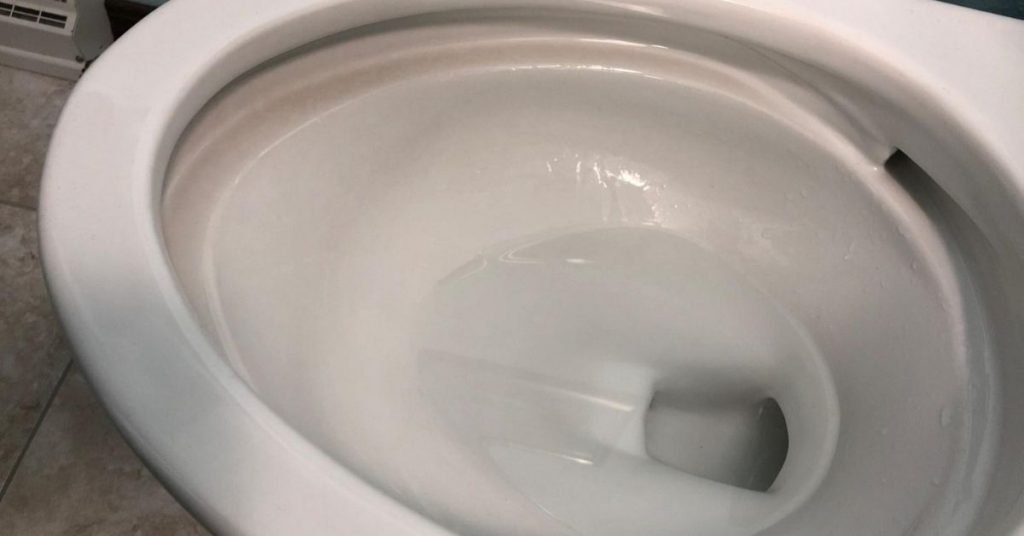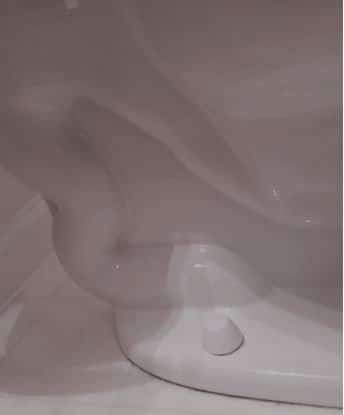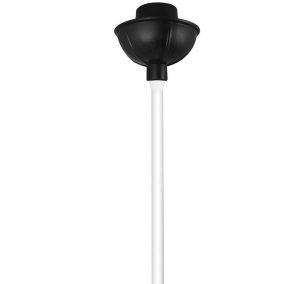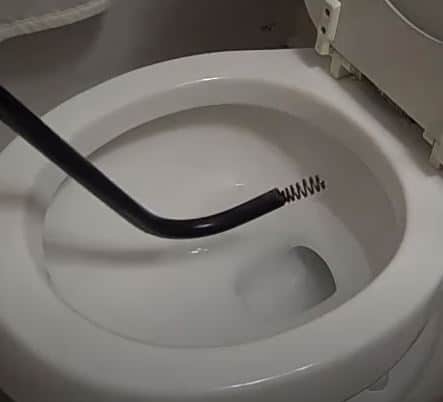Slow Draining Toilet? Here is How to Fix It Quickly
Last Updated on October 4, 2023 by toilethaven
Why is My Toilet Draining Slowly?
Toilets depend on gravity to produce a suction/siphon effect, which pushes waste from the bowl up and down the trap and out into the drainpipe. For that to happen, both the toilet trap and drainpipe have to be free of obstructions.
A partial clog in the toilet trap or drainpipe almost always causes a slow-draining toilet. The clog creates a restriction that prevents waste from flowing out as fast as it should and may even develop into a full clog if not fixed. In a few instances, a clogged plumbing vent could be the culprit.

When a slow-draining toilet is caused by a clogged vent stack, you can always tell. A clogged vent stack will also affect other fixture drains in the house, and you will also notice the bathtub or sink draining slowly.
To fix a slow-draining toilet, drain the bowl completely, then pour 1 cup of baking soda and 2 cups of vinegar. Follow it up with a gallon of hot water after 15 minutes. Alternatively, plunge the toilet or snake it using a toilet auger. Unclog the vent stack as well.
Let us now look at all the things that cause a slow, draining toilet in more detail.
1. Clogged Toilet Trap

A toilet trap is a U-shaped bend at the bottom of the toilet, which looks like an inverted P, which is why it is also known as a P-trap. Every fixture in your house has a P-trap for two reasons:
- It holds a steady amount of water in the bowl, which acts as a barrier preventing sewer gases from entering the bathroom.
- It traps potential clogs, preventing them from clogging the drainpipe further below where it would be way harder to unclog
The toilet trap, unlike other drain traps, has one more importance. This is what allows a toilet to flush. The siphon effect is generated here.
It has a short leg and a long leg. Once you flush the toilet, water fills the bowl suddenly, filling the toilet trap’s short leg. When that happens, wastewater flows and fills the long leg as well.
The weight of water in the long leg will pull the water in the short leg and the bowl until all wastewater has been siphoned out. This is how a basic siphon works.
If there is a clog in the toilet trap, you will notice that the siphon is not as strong as it used to or should be, and you may also need to flush the toilet twice.
2. Clogged Drainpipe
All the fixtures in your house have separate drainpipes. All these separate drainpipes are further down connected and drain to the main house drainpipe, which in return drains to the city’s sewer lines or septic tank.
If the toilet drainpipe is partially clogged, you will have a slow-draining toilet. When you flush the toilet, you will notice that the bowl fills with water, draining slowly.
If you have several toilets in the house, check if the problem is with only one toilet or all of them. Also, check if other fixtures in the house, like sinks and tubs/showers, are draining slowly as well.
Sometimes, draining fixtures are caused by tree roots in the sewer lines. If not killed while still small, tree roots in sewer lines will force you to replace the sewer pipes, which is not cheap.
3. Clogged Vent Stack
A vent stack is the vertical pipe running from your house’s drain pipe through the house’s roof. It provides a way for sewer gases to flow out of the drainpipe and also allows free circulation of air in the drainpipe.
If the vent stack is clogged, pressure will build up inside the drainpipes, causing a slow-draining toilet. Other signs of a clogged vent stack are:
- Toilet bubbling when flushed.
- Bathtub/shower drain gurgling when the toilet is flushed.
- The toilet is bubbling when the shower is drained.
- Sewer smell in the house.
Unless the problem is with your other fixtures, a clogged vent stack cannot affect only one toilet.
How to Fix a Slow-Draining Toilet
Fixing a slow-draining toilet is quite easy; in most cases, you will not even need to call in a plumber. You can use several ways to fix a slow-draining toilet, depending on what is clogging it.
Here are some of the ways to unclog a slow-draining toilet, starting off with the easiest to the hardest:
1. Break Down the Clog with Baking Soda and Vinegar
Baking soda is an alkali, while vinegar is a weak acid. These two products, which are cheap and readily available, react together quickly in a fizzing reaction when combined.
The process of reacting together helps break down the clog inside the P-trap or drain line. This usually works very well if the clog is caused by toilet paper, soap, or calcium deposits, among other substances.
Note: You can use borax instead if you do not have baking soda. Borax is stronger than baking soda.
This is how to unclog the toilet using baking soda and vinegar:
- Drain the toilet bowl. Since you want the solution to work on the clog directly and not be diluted, start by draining the water at the bottom of the bowl completely.
- Pour 1 cup of baking soda into the bowl.
- Slowly add 2 cups of vinegar.
- Give the solution 15 minutes to work out its magic. As you do so, start boiling some water.
- Dump 1 gallon of hot water inside the bowl. The water will help flush the broken-down clog down the drain and dissolve any clog that is still solid. Use only hot water, not boiling water, since it can crack the bowl.
2. Use Hot Water and Dish Soap
This is another good method to unclog a slow-draining toilet without a plunger or snake. Here is how to proceed:
- Use a sponge to soak up the water at the bottom of the toilet bowl. Please remember to have your gloves on.
- Pour about half a cup of dish soap into the toilet bowl.
- Dash to the kitchen and boil about 1 gallon of water.
- Dump the water in the bowl and give it time to work out its magic.
- After 30 minutes, flush the toilet and check if its draining rate has improved.
- You might need to do this a few times to fix the problem completely
If your toilet trap or drainpipe was clogged by toilet paper or a bar of soap, the hot water will help break the clog into smaller pieces and, in the process, unclog the toilet, improving its draining rate.
3. Use a Toilet Plunger

A toilet plunger is an effective tool for dislodging clogs from the toilet trap or drainpipe. It works by creating a pressure differential between the top and bottom of the clog, where the pressure at the top is more than the one below it.
This forces the clog to move further down the drainpipe and, in the process, restore your toilet’s draining rate.
Remember to select the right plunger for your toilet. There are two types of plungers. Flat-bottomed plungers and bell-shaped plungers. The right toilet plunger is the bell-shaped one.
It seals perfectly around the toilet bowl opening allowing you to send maximum pressure down the drainpipe. This is how to fix a slow-draining toilet using a toilet plunger:
- Add some water to the bowl. To plunge effectively, the bottom of the plunger needs to be fully immersed in water.
- Position the plunger gently on the toilet bowl’s opening and ensure it seals all around the opening. Some people apply Vaseline around the plunger’s rim to help it seal better.
- Start plunging. The first plunge needs to be gentle to help the plunger form a tight seal on the toilet bowl opening. After the first plunge, start plunging aggressively for a few minutes.
- Lift off the plunger and flush the toilet. Has the draining rate improved? If not, plunge some more.
If you want to explore more ways of unclogging a toilet without a plunger, check out this post.
4. Use a Toilet Auger

A toilet auger, also known as a plumber’s snake, is a device used to unclog toilets by shredding the clogs into smaller pieces or even pulling them out. It has a spiral, hooked head, flexible cable, and cranking handle.
The main problem with using a toilet auger is that it can badly scratch your toilet bowl if you are not careful. Fortunately, it has a protective guide that helps you introduce and pull the head without contacting the bowl’s surface.
Here is how to unblock a slow-draining toilet using a toilet auger:
- Pull the cable inside the tube such that the head of the auger is at the bowl guard.
- Slowly introduce the auger inside the bowl and position it on the bowl’s opening.
- Start pushing the cable down through the toilet trap until you encounter resistance.
- Crank the handle clockwise until you go through the restriction. If it feels too hard, crank the handle in the opposite direction and start again.
- When you finally go through the restriction or if it feels too hard, pull the cable inside the tube and lift off the bowl guide and tube without making contact with the inside of the bowl.
- If you manage to pull out the clog, flush the toilet and check if it is draining properly again. If not, insert it again and try once more.
For more information on how to unclog a toilet with a plunger, check out this post.
5. Unclog the Vent Stack
If the toilet and other fixtures in your house indicate that you have a clogged vent, then unclogging it is quite easy. Here is how to unclog a vent stack:
- Climb to the roof of your house with a garden house in hand.
- Check if blockages are at the top of the vent that you can easily remove with your hand.
- Stick the end of the garden hose inside the vent and use it to probe it. You might just dislodge the clog.
- Have someone turn on the water to the garden hose. The weight of the water is usually enough to unclog it.
- If the water doesn’t do it, upgrade to a plumber snake.
- Push the snake in the vent until you encounter a restriction. Crack the handle until you hook the clog. Pull it out and push the snake back again to check for more clogs.
- Flush the toilet and check if the draining rate has increased.
Slow Flushing Toilet?
Often, people confuse slow-flushing toilets with slow-draining toilets. Several factors cause slow/weak flushing toilets, including clogged siphon jets and rim holes.
This is usually a problem for people living in areas with hard water. Minerals, especially calcium, block the rim holes and/or siphon jet, meaning that water from the toilet tank enters the bowl slowly, resulting in a weak flush.
Cleaning the toilet siphon jet and rim holes will, without a doubt, solve the problem. More information about how to unclog siphon and rim jets is in this post.
Another cause of a slow flushing toilet could be a result of a loose lift chain. A lift chain is a chain that connects the toilet handle and the toilet flapper. When it is too loose, it will not fully lift the flapper during flushing, and hence, the water will drain from the tank to the bowl slowly.
I have written a detailed post on how to fix a slow-flushing toilet. Read it here.